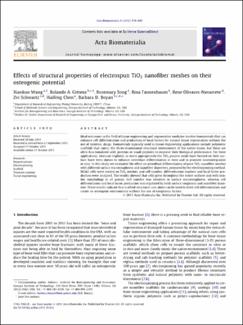| dc.contributor.author | Wang, Xiaokun | |
| dc.contributor.author | Gittens, Rolando A. | |
| dc.contributor.author | Song, Rosemary | |
| dc.contributor.author | Tannenbaum, Rina | |
| dc.contributor.author | Olivares-Navarrete, Rene | |
| dc.contributor.author | Schwartz, Zvi | |
| dc.contributor.author | Chen, Haifeng | |
| dc.contributor.author | Boyan, Barbara D. | |
| dc.date.accessioned | 2020-07-24T03:46:25Z | |
| dc.date.available | 2020-07-24T03:46:25Z | |
| dc.date.issued | 2011-10-31 | |
| dc.identifier.other | doi:10.1016/j.actbio.2011.10.023 | |
| dc.identifier.uri | http://repositorio-indicasat.org.pa/handle/123456789/217 | |
| dc.description | Ideal outcomes in the field of tissue engineering and regenerative medicine involve biomaterials that can enhance cell differentiation and production of local factors for natural tissue regeneration without the use of systemic drugs. Biomaterials typically used in tissue engineering applications include polymeric scaffolds that mimic the three-dimensional structural environment of the native tissue, but these are often functionalized with proteins or small peptides to improve their biological performance. For bone applications, titanium implants, or more appropriately the TiO2 passive oxide layer formed on their surface, have been shown to enhance osteoblast differentiation in vitro and to promote osseointegration in vivo. In this study we evaluated the effect on osteoblast differentiation of pure TiO2 nanofiber meshes with different surface microroughness and nanofiber diameters, prepared by the electrospinning method. MG63 cells were seeded on TiO2 meshes, and cell number, differentiation markers and local factor production were analyzed. The results showed that cells grew throughout the entire surfaces and with similar morphology in all groups. Cell number was sensitive to surface microroughness, whereas cell differentiation and local factor production was regulated by both surface roughness and nanofiber diameter. These results indicate that scaffold structural cues alone can be used to drive cell differentiation and create an osteogenic environment without the use of exogenous factors | en_US |
| dc.description.abstract | Ideal outcomes in the field of tissue engineering and regenerative medicine involve biomaterials that can enhance cell differentiation and production of local factors for natural tissue regeneration without the use of systemic drugs. Biomaterials typically used in tissue engineering applications include polymeric scaffolds that mimic the three-dimensional structural environment of the native tissue, but these are often functionalized with proteins or small peptides to improve their biological performance. For bone applications, titanium implants, or more appropriately the TiO2 passive oxide layer formed on their surface, have been shown to enhance osteoblast differentiation in vitro and to promote osseointegration in vivo. In this study we evaluated the effect on osteoblast differentiation of pure TiO2 nanofiber meshes with different surface microroughness and nanofiber diameters, prepared by the electrospinning method. MG63 cells were seeded on TiO2 meshes, and cell number, differentiation markers and local factor production were analyzed. The results showed that cells grew throughout the entire surfaces and with similar morphology in all groups. Cell number was sensitive to surface microroughness, whereas cell differentiation and local factor production was regulated by both surface roughness and nanofiber diameter. These results indicate that scaffold structural cues alone can be used to drive cell differentiation and create an osteogenic environment without the use of exogenous factors | en_US |
| dc.format | application/pdf | |
| dc.language.iso | eng | en_US |
| dc.rights | Info:eu-repo/semantics/openAccess | |
| dc.rights | https://creativecommons.org/licenses/by/4.0/deed.es | |
| dc.subject | Nanostructures Electrospinning | en_US |
| dc.subject | Scaffold Titanium | en_US |
| dc.subject | implant Tissue engineering | en_US |
| dc.title | Effects of structural properties of electrospun TiO2 nanofiber meshes on their osteogenic potential | en_US |
| dc.type | info:eu-repo/semantics/article | en_US |
| dc.type | Info:eu-repo/semantics/publishedversion | |

